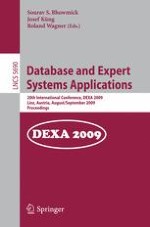This book constitutes the refereed proceedings of the 20th International Conference on Database and Expert Systems Applications, DEXA 2009, held in Linz, Austria, in August/September 2009. The 35 revised full papers and 35 short papers presented were carefully reviewed and selected from 202 submissions. The papers are organized in topical sections on XML and databases; Web, semantics and ontologies; temporal, spatial, and high dimensional databases; database and information system architecture, performance and security; query processing and optimisation; data and information integration and quality; data and information streams; data mining algorithms; data and information modelling; information retrieval and database systems; and database and information system architecture and performance.
